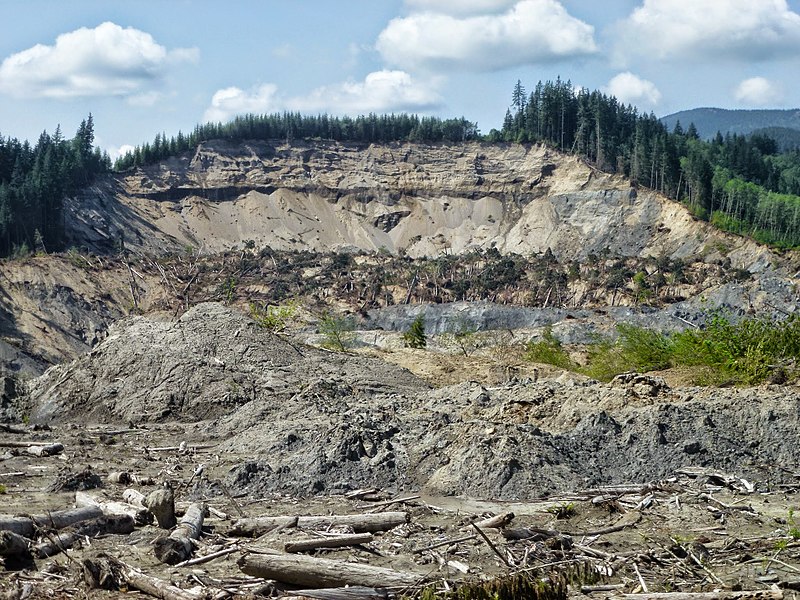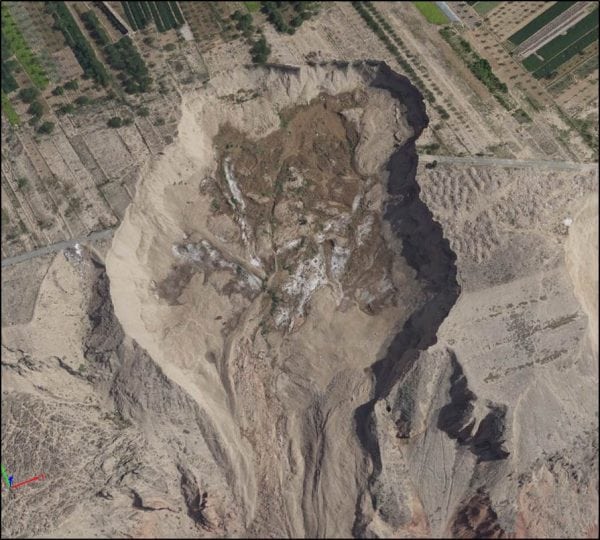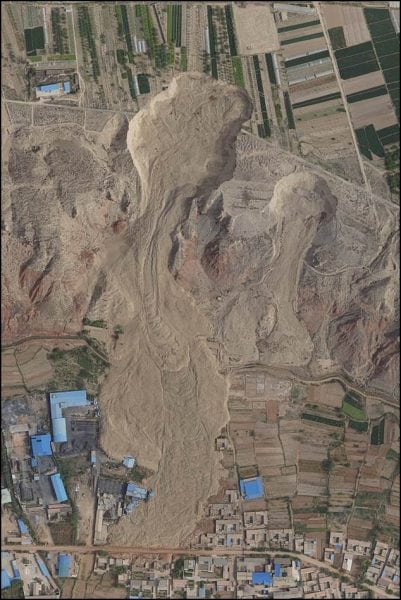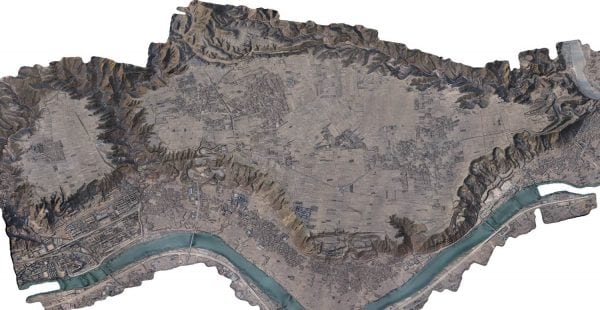
Loess is a wind-blown sediment made of micron-sized grains of quartz, feldspar, and mica, calcium and magnesium carbonates and up to 30% of clay. As a result of its genesis, it has high porosity and vertical joints which facilitate the water infiltration and sub-surface circulation. Thick loess deposits are considered “problematic soils” because they can collapse suddenly and in large volumes, resulting in destructive landslides.
Loess is widespread throughout the world, but the largest and thickest deposits are in China, where they cover more than 630,000 km2. Among them, the Loess Plateau of north-western China is the largest one. Due to the arid climate, people living in this area largely rely on the irrigation water pumped from the Yellow River for cultivation. They use the “flooding method” several times a year, due to which large volumes of water can infiltrate to depths of tens of meters.
What Is Loess?
Loess is not a rock, it is a soil which is poorly cemented by carbonate crystals, while a good part of its strength derives from the capillarity forces exerted by the moisture within the soil pores when the soil is unsaturated (which is its natural conditions in these arid areas). The clay component, due to its hygroscopic properties (it is able to retain water) plays an important role in developing such forces, thanks to which the loess can exhibit beautiful landforms [1],[2],[3] and has been used for ages by the locals for digging cave dwellings[4],[5].
Several studies showed that the intense irrigation in the loess plateau is correlated with the increasing number of landslides occurring every year, possibly because of the increase of moisture in the deep layers of soil and the consequent decrease of the capillary forces and the slow dissolution of the carbonate cement[6].
But there is more. A study published in 2012 in Engineering Geology [7] showed that at the base of the loess plateau in our study area (the Heifangtai terrace, in Gansu province) many springs of mineralized water and salt encrustations can be found. The springs are practically the irrigation water which outflows from the loess after infiltrating, traveling underground and being enriched with the minerals (mainly NaCl – table salt! – and some calcium and magnesium carbonate and sulfate) the loess naturally contains.

Source location of a loess landslide. Credit: Xuanmei Fan
Unstable Loess Soils Prone To Mass Failures
Clays are very sensitive to the presence of salt in the pores. They can swell or shrink and their strength and stiffness can change really a lot if they get in contact with freshwater (weaker behavior) or with salty water (stronger). The effect can be so great that adding salt to a slurry made of “quick clay” (a type of illitic clay common in Scandinavian countries and Canada) will turn the slurry into a solid (there is a pretty scene in an educational video by the Norwegian Geotechnical Institute on YouTube [8]), and salt columns are being tested as an ecological alternative to stabilize clay deposits and clay landslides (see the work of the NTNU in Norway [9],[10],[11]and that of the Unibas [12],[13],[14],[15]in Italy.
Thus, our research question was: is it perhaps the salt content of the loess that controls, at least in part, the loess strength and its potential to generate destructive landslides? So, we devised an experimental program at the SKLGP laboratory in Chengdu[16] (by the way, we have an open call for 5 new postdocs[17], and we are going to hold, in October, a very nice doctoral school on large landslides![18]).
Testing Loess Samples
One series of tests were pretty simple: we weighted an amount of dry loess and we added the irrigation water which we collected from the field. We stirred, sealed the containers and left the suspensions to settle for 1 day, 3 days … 1 month and more. After 1 day, 3 days, etc., we analyzed the chemical composition of the water solution to see how much salt was dissolved and, separately, we analyzed the loess particles to see if they changed size and shape. Indeed, the loess aggregates broke down, the carbonate started to dissolve, and the clay particles swelled (we took nice photos of the loess grains and of the clay flakes with a Scanning Electron Microscope). Most of the NaCl had dissolved into the irrigation water very quickly, while the carbonate (as we expected) was dissolved only in a small amount during our experiment, as its reaction is much slower and depends on the pH of the solution.

Dangchuan Landslide. Credit: Xuanmei Fan
Thanks to the chemical analyses, we could estimate that, in the natural, unsaturated condition, the small amount of water which helps the loess grains stick together is actually very salty (55 grams/Liter), much saltier than seawater (35 g/L)! But, when the irrigation water infiltrates and the loess becomes water-saturated, the concentration drops to less than 7 g/L, and the salt is washed away through the pores and fractures of the loess until it comes out from the springs at the base of the slopes and goes away with the river. With such a change of salinity, we thought, the strength of the clay component can change really a lot (in some clays, it can decrease to one-half or even to one-third of the initial strength[19],[20])
So, in another series of tests, the “ring-shear tests” (practically, we compressed and sheared the soil sampled to simulate, in small scale, the initiation and evolution of a landslide), we used loess samples with natural moisture content, or after we soaked them in water for several days, and also samples of loess prepared by mixing the soil with fixed amounts of freshwater or salt water. We found, as expected, that when the loess becomes saturated by water, its strength decreases significantly. But we found also that this is not just due to the water itself (that is, to the decrease of capillary forces) but it also depended on which water we used. Loess tested in salty water showed a strength quite higher than that of the loess tested in fresh water. And, after washing the loess repeatedly to remove even its natural salt, we measured an even lower strength. Looking at the test results, it seems that the strength loss of our loess can be attributed to 50% to the water saturation process, and by 50% by the change of water chemistry.
In our work, we tried to look at the problem of loess landslides this different point of view: it has a strange name – chemo-mechanical coupling – but it is not scary, it simply refers to the link between the soil properties and the chemical interaction between soil and water. It is not a new field (the first chemo-mechanical studies on soils date back to the ‘50s), but it is gaining new attention among engineering geologists, geotechnical engineering, and hydrologists, thanks to recent developments in laboratory testing, soil modeling, and monitoring techniques. In the past years, we’ve been learning that the presence of some substances in the water (from simple dissolved salts to organic compounds and nanopolymers) can change the strength of soils, their permeability, even their response to earthquakes, can stabilize buildings and roads foundations, can save us from nuclear waste radiation, can trigger landslides and can also stop them invisibly, without building concrete walls or reshaping mountains.

Full view of Heifang Terrace. Credit: Xuanmei Fan
It takes just a pinch of salt. Fascinating, isn’t it?
This article was contributed by Xuanmei Fan from the State Key Laboratory of Geohazards Prevention and Geoenvironment Protection (SKLGP), Chengdu University of Technology. Xuanmei Fan, Dr. Gianvito Scaringi, and Prof. Qiang Xu published the study, “A chemo-mechanical insight into the failure mechanism of frequently occurred landslides in the Loess Plateau, Gansu Province, China” in Engineering Geology.
References
- [1] http://www.china.org.cn/travel/2016-11/10/content_39677296.htm
- [2] http://regenerationinternational.org/2016/01/22/a-continuing-inquiry-into-ecosystem-restoration-examples-from-chinas-loess-plateau-and-locations-worldwide-and-their-emerging-implications/
- [3] http://www.ecns.cn/visual/hd/2017/03-28/125373.shtml
- [4] https://chinablog.cc/2009/02/yaodong-cave-dwellings-on-loess-plateau/
- [5] https://clare-research-trip.blogspot.com/2011/04/chairman-mao-and-yaodong-cave-dwellings.html
- [6] e.g. Zhang et al. (2009), http://dx.doi.org/10.1007/s10346-008-0135-2
- [7] Wen and He (2012), http://dx.doi.org/10.1016/j.enggeo.2012.08.005
- [8] https://youtu.be/3q-qfNlEP4A?t=152
- [9] Helle et al. (2016), https://www.nrcresearchpress.com/action/cookieAbsent
- [10] Helle et al. (2017a), http://dx.doi.org/10.1007/978-3-319-56487-6_4
- [11] Helle et al. (2017b), http://dx.doi.org/10.1061/(ASCE)GT.1943-5606.0001774
- [12] Di Maio et al. (2015), http:/dx.doi.org/10.1007/s10346-014-0511-z
- [13] Di Maio and Scaringi (2016), http:/dx.doi.org/10.1016/j.enggeo.2015.11.007
- [14] Pontolillo et al. (2016), http:/dx.doi.org/10.1016/j.proeng.2016.08.407
- [15] De Rosa et al. (2016), http://dx.doi.org/10.1016/j.proeng.2016.08.443
- [16] http://en.sklgp.com/en/
- [17] http://dx.doi.org/10.13140/RG.2.2.25947.46883
- [18] http://irall.sklgp.com/en/school/index.html
- [19] Di Maio (1996), http://dx.doi.org/10.1680/geot.1996.46.4.695
- [20] Di Maio et al. (2016),









